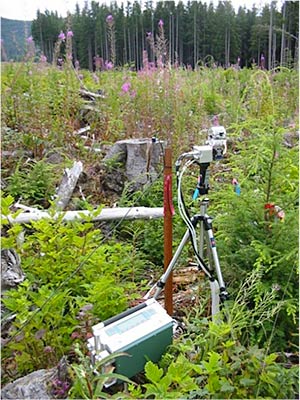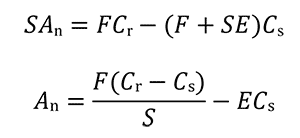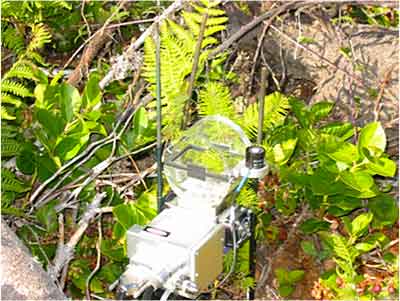Click here to download a video notes sheet before watching the following video.

LI-COR LI-6400 photosynthesis measurement system
The productivity of a given agricultural crop or stand of trees depends on the photosynthetic uptake of carbon by the individual plants. Hence the measurement of photosynthesis, the process by which plants convert solar energy to chemical energy, is of great importance. During photosynthesis, carbon dioxide (CO2) diffuses into the plant through stomatal pores on leaf surfaces, where it is fixed internally as carbohydrates, while oxygen and water vapour (H2O) are released. Leaf chamber photosynthesis systems measure the rate of removal or production of CO2 and H2O exchanged in a stream of ambient air passed through a leaf chamber. The LI-COR LI-6400 photosynthesis measurement system uses this principle and is an effective tool for determining photosynthetic uptake and assessing the response of photosynthesis to changing environmental variables (e.g. temperature, humidity, light).
The LI-COR LI-6400 photosynthesis measurement system consists of 4 main components:
- A leaf chamber: The chamber is made from transparent acrylic plastic to transmit solar radiation to the leaf. Different shaped chambers are used to enclose broad leaves and conifer shoots.
- Infrared gas analyzers (IRGAs): There are two gas analyzers, one receives a stream of gas that passes through the leaf chamber (sample), and one passes directly to the analyzer without passing through the leaf chamber (reference). The difference between the CO2 concentration in these gas streams is then used to calculate the uptake from photosynthesis.
- CO2 and H2O scrubbers: The combination of a CO2 scrubber (soda lime) and a small CO2 cartridge containing 100% CO2 allow the user to control the CO2 concentration inside the leaf chamber, and to conduct experiments at CO2 concentrations above and below ambient levels of CO2. An H2O scrubber is used to dry the gas streams before they are measured in the IRGAs, hence the effects of dilution by water vapour on CO2 concentration are removed.
- A computer console: This is used for data logging, measuring photosynthetically active radiation (PAR), leaf chamber climate control (air temperature, humidity), measuring and maintaining CO2 levels (see #3 above), and for gas flow control.

Schematic of an open chamber system for measuring leaf photosynthesis
The net photosynthesis calculation, done internally by the LI-6400, can be best explained schematically:
Amount of CO2 removed through net photosynthesis of leaf in chamber = CO2 entering chamber – CO2 leaving chamber


where:
Cr and Cs are reference and sample cell cell CO2 concentrations (μmol CO2 (mol air)-1), respectively.
F is the flow rate of air entering the chamber (mol air s-1)
An is net assimilation rate of CO2 by the leaf (μmol CO2 m-2 s-1).
S is the surface area of the leaf (m2).
E is the transpiration rate of the leaf (mol H2O m-2 s-1).
Note that the contribution of water vapour from leaf transpiration causes the exit molar flow rate to be higher than the entrance molar flow rate.
References:
- Using the LI-6400 / LI-6400XT Portable Photosynthesis System Version 6, LI-COR Biosciences, Lincoln, NE. (http://sites.middlebury.edu/biol323/files/2011/01/6400MAN.pdf .